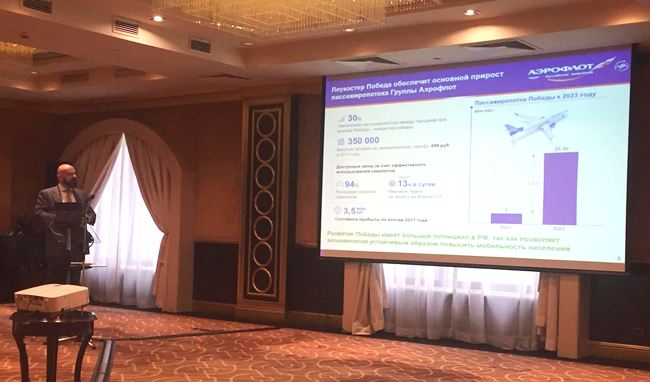
Dear members of the Public Council! General Director Vitaly Gennadievich Savelyev, unfortunately, was unable to personally take part in the meeting, and asked me to report to you on the strategy of the airline for a 5-year period. This question was reported by Vitaly Gennadievich to the President of Russia, received support and approval. And you are actually the first members of the public who recognise it in the expanded form, looking at the very presentation that President Vladimir Vladimirovich Putin saw and approved.
In 2023, we will celebrate the centenary of Aeroflot. And how can you meet him? You can meet some serious achievements. For instance, 100 million passengers. What we plan to do in the framework of the new strategy is 5 main points, I will dwell on each one in more detail.
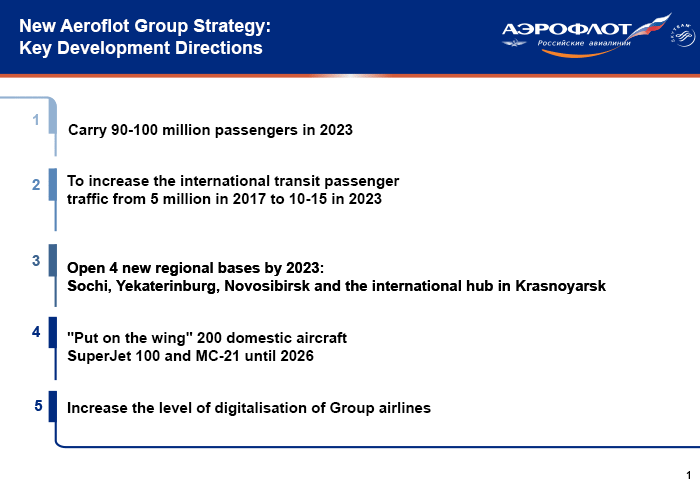
In 1990, the then Soviet Aeroflot was listed in the Guinness Book of Records as a company that transported 139 million passengers. Such a figure at that time could not reach any foreign airline, including European and American giants. After the collapse of the Soviet Union, the downsizing and crushing of the airline, in 1994, Aeroflot was carrying just over 3 million passengers. Imagine the extent of the fall? In 2009, when the new team arrived, the company was carrying just over 11 million passengers.
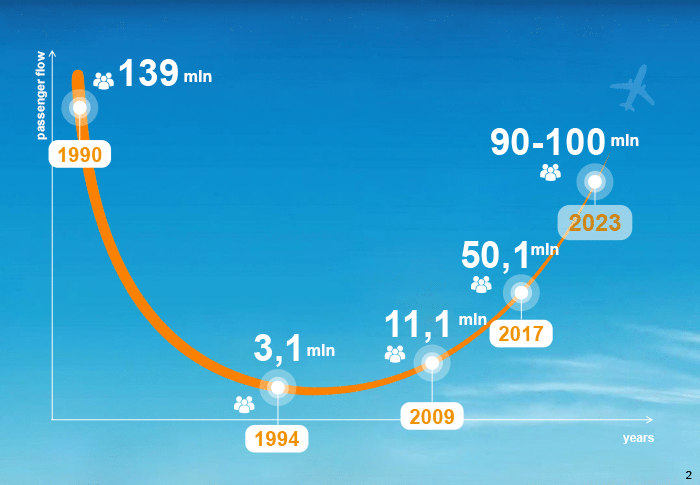
At the moment, by the end of 2017, we carried more than 50 million passengers as a Group of Companies. And we set ourselves an extremely ambitious task, it causes skepticism in many, but we go for it with open eyes, that in 5 years, in 2023, we will transport from 90 to 100 million passengers a year. That is, we will substantially approach the figure that Aeroflot had when it was an all-Union company of the USSR, and not just a Russian one.
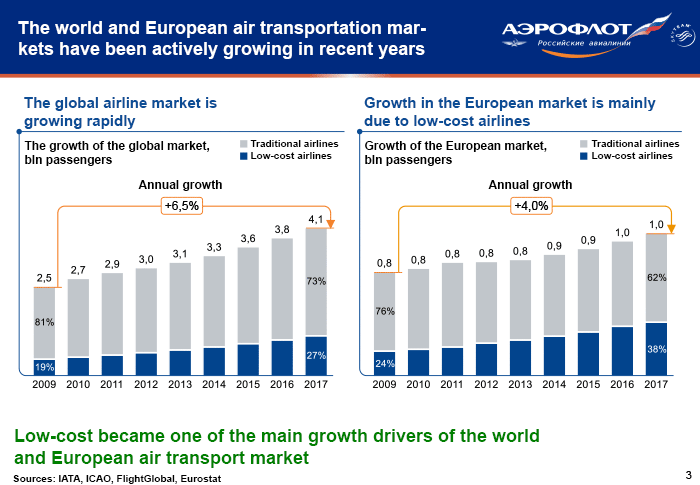
What characterises the world and European air transportation market now? They really grow. The annual average growth of the European air transport market since 2009 is 6.5%. The main driver that provides growth in Europe and around the world is low-cost airlines.

The Russian market is also growing, with the exception of 2015-2016. Now returned the trend of annual growth. We believe our consultants confirm this forecast that it will grow by more than 6% annually, which allows us to draw optimistic conclusions that we will be able to seriously increase passenger traffic for ourselves.

The Russian market grew on average by 10% per year, the Aeroflot Group is growing faster than the Russian market. And in many respects the Russian market is growing due to the rapid growth of the Aeroflot Group.
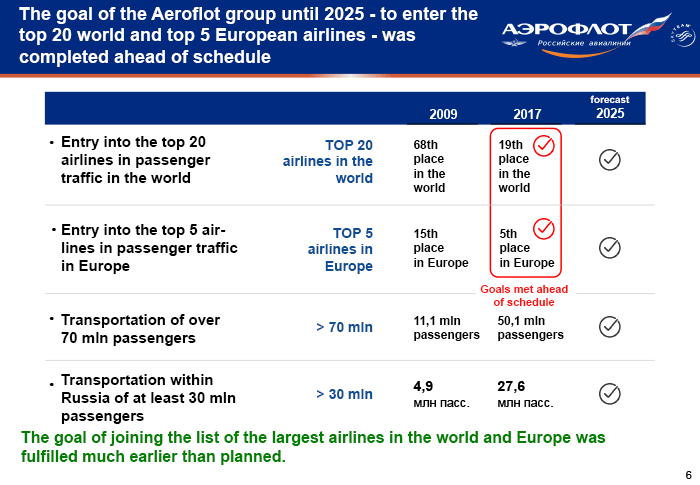
Back in 2015, we set ourselves some tasks that should have been completed in 2025. But thanks to the passengers, thanks to the good work of all the employees of the company, we were able to achieve most of the goals 8 years ahead of time by 2017. We had to enter the top 20 airlines in terms of passenger traffic in the world. In 2009, we were the 68th, the task was to enter the top twenty for 2025, but already in 2017 we became the 19th in the world. We also had to enter the top 5 airlines in terms of passenger traffic in Europe, starting from the 15th place in 2009, in 2017 became the fifth. In 2025, more than 70 million passengers were to be transported. Based on the fact that two goals have already been achieved ahead of time, this allows us to conclude that the new ambitious goal can be accomplished.
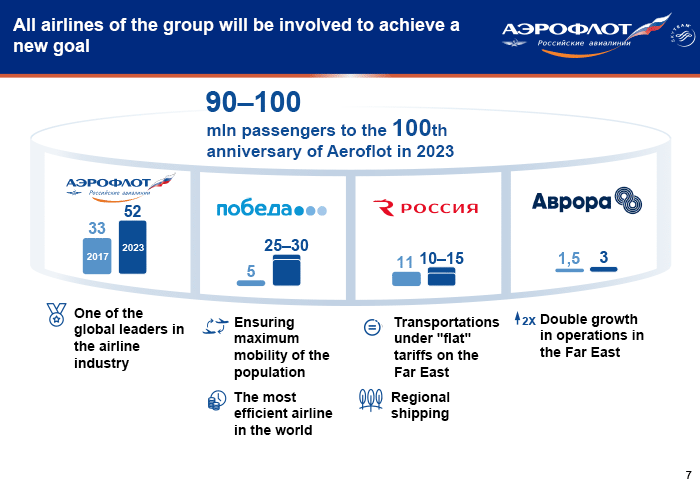
How will passenger traffic be distributed among all Group companies? It is clear that all 4 airlines that are part of the Aeroflot Group will actively participate in increasing passenger traffic. With 33 million in 2017, Aeroflot will transport 52 million. We will still position Aeroflot as a premium class company. Therefore, there is no such huge growth here, as our low-cost airline Pobeda has shown. We believe that it will be the main growth driver. Growth from 5 million passengers in 2017 to 25-30 million in 2023. Rossiya Airlines will transport people at social fares, primarily to the Far East, and close the regional transportation. And our Far Eastern company Avrora will double the operations in the Far East.
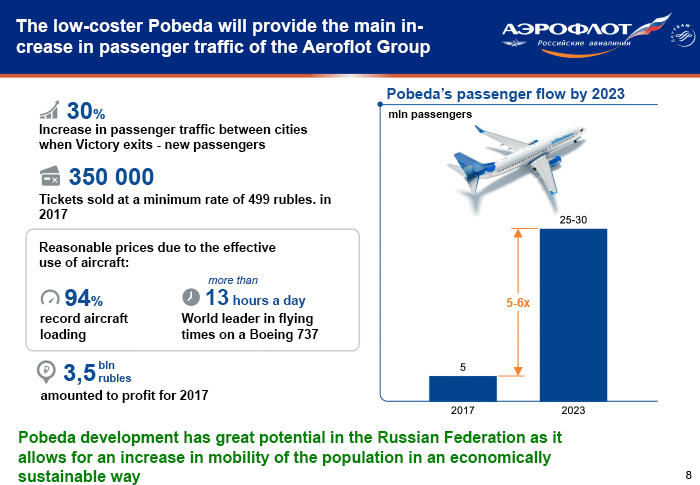
As I have already said, the main driver of growth will be Pobeda Airlines. We can say that as soon as the company enters a market, there is an immediate increase in passenger traffic between cities, where it begins to fly, by 30%. These are new passengers who change from cars that change from trains to the Pobeda company. 350 thousand tickets were sold in 2017 at the rate of 499 rubles. Record loading of airplanes is 94%, one can only dream of this, including at the level of world low-cost airlines. Pobeda is the world leader in terms of flying on Boeing 737 aircraft - 13 hours a day, each aircraft is in the air. For comparison, in Aeroflot, and this is also a very high indicator, a similar type of aircraft is in the air 9.5 hours a day. And the profit at the end of 2017 amounted to 3.5 billion rubles. When we launched the Victory project itself, we planned that it would come to profit after the first three years, which was a rather optimistic forecast. But in the first year, the airline showed a profit, and by the end of 2017, this is already a noticeable profit compared to all Russian airlines. The potential of Pobeda is crazy. Every 2-3 weeks we receive offers from regional authorities, who ask the airline to start flying to their region. We are ready to give discounts on service at the airports, if only Pobeda went there. Because it is clear that now, given the economic situation in the country, the population does not have serious means of transportation for more expensive airlines. At this moment, a low-cost airline comes to the rescue. This product is highly demanded.
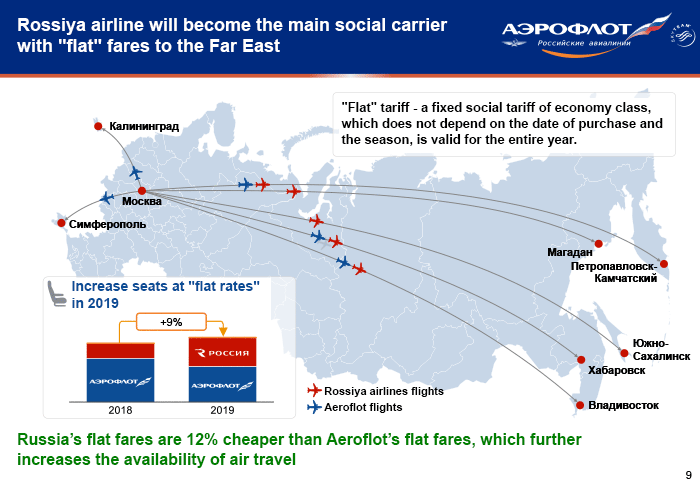
What will be the «Rossiya" airline? Now the company is based mainly in St. Petersburg. In Moscow, it used to be based at Vnukovo Airport, but now it has almost completely moved to Sheremetyevo Airport. From the beginning of the next summer schedule, it will already fly completely from Sheremetyevo. I will explain what additional benefits arise from this. It will focus on those flights that we operate at a flat, that is, fixed fares. These are flights to Kaliningrad, Simferopol, and most importantly, these are flights to five cities of the Far East: Vladivostok, Magadan, Petropavlovsk-Kamchatsky, Yuzhno-Sakhalinsk, Khabarovsk. Flat tariffs of Rossiya Airlines themselves are cheaper than Aeroflot flat fares, due to a simpler service, although it is not inferior to Aeroflot. And, accordingly, given the fact that prices are lower, this increases the availability of air transportation.
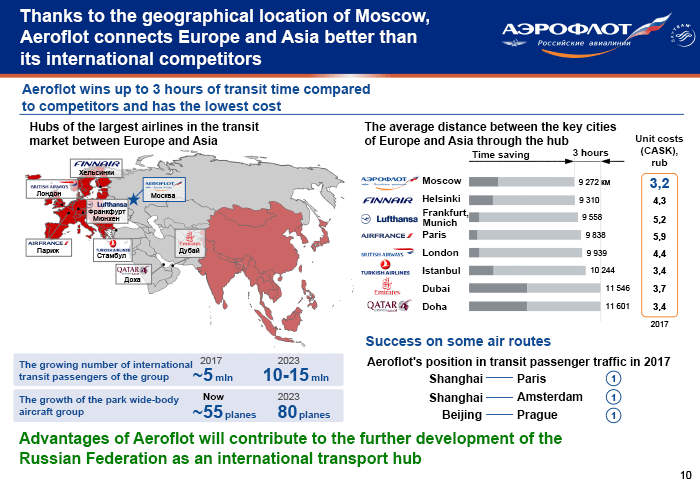
Our second global goal is to increase the international transit passenger traffic from 5 million to 10-15 million passengers a year. We pick up foreign passengers flying from east to west, from west to east. Moscow is a unique hub, even in relation to already existing European (such as Helsinki, Frankfurt, Munich, Paris ...), due to the smaller distance from point to point. On the slide, you see time savings due to the passage through Moscow. Since for aviation every cent counts, this is quite a serious competitive advantage. Especially significant is the difference with respect to flights through London, Istanbul, Dubai, Doha - up to 3 hours of saving flight time. And now in some directions we are number one in passenger traffic, for example, Shanghai-Paris, Shanghai-Amsterdam, Beijing-Prague. We want to close the entire Chinese transit to Europe and, possibly, the transit of other Asian countries. It is clear that here, first of all, it will be a matter of allowing the airport to quickly digest a sufficiently large number of transit passengers, which we are now actively working on with the management of Sheremetyevo Airport.
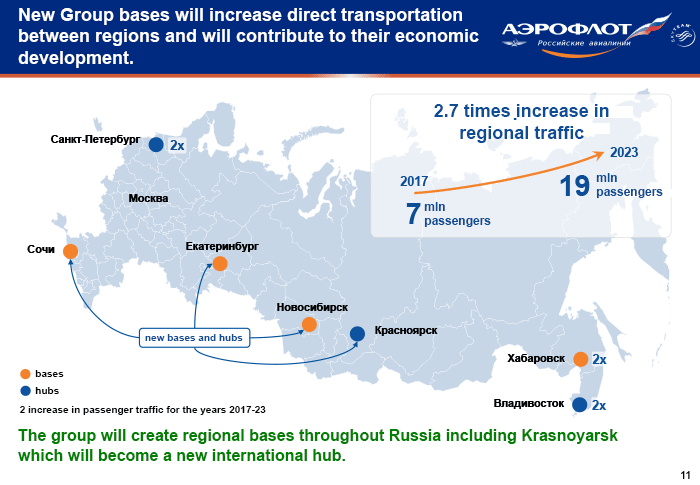
Third. There is the so-called May decree of the President of Russia that it is necessary to unload the Moscow air hub from internal transit, which, for obvious reasons, overloads Moscow airports both on land and in the air. Because the main part of air passengers, which moves through the territory of Russia, moves through Moscow. How can I do that. This can be done only by creating regional bases in various cities. This was a very serious debatable issue, because in many respects it determines our development not even until 2023, but for a very serious future. And the following cities were chosen as regional bases: Sochi, Yekaterinburg, Novosibirsk and an international hub in Krasnoyarsk. The international hub in Krasnoyarsk will differ from the first three cities in that there will be basing of aircraft in large enough numbers, and this will again spread from China to Europe, etc. As the calculation of our consultants shows, and our internal calculations, the appearance of a hub in Krasnoyarsk will be able to pull back quite a large number of passengers from Moscow. We believe that the implementation of this program will allow us to increase regional transport by more than 2.5 times. Now they amount to 7 million passengers, and by 2023, out of 90-100 million passengers, 19 will fall to regional traffic.
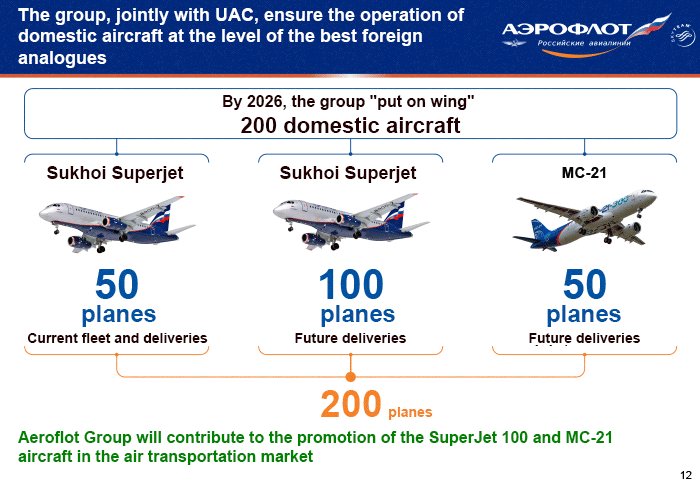
Fourth, 200 domestic SuperJet 100 and MC-21 aircraft. Now in our fleet of 50 SuperJet 100 aircraft, we have entered into an agreement on the delivery of another 100 such aircraft and 50 MC-21. We expect the first delivery of the MC-21 either at the end of 2019, or at the beginning of 2020, and we look forward to this aircraft. According to the characteristics declared by the manufacturer, it must be at a good competitive level.
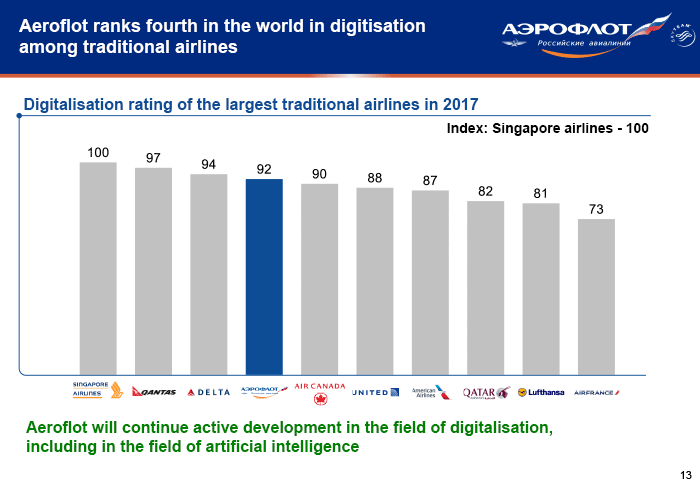
And finally, the fifth is to increase the level of digitalisation of the Group companies. Nowadays, the development of air travel worldwide is associated with the development of digitalisation. A person is less involved in the process of servicing a passenger, more and more artificial intelligence comes to replace a person. And now we can proudly say that we are, according to the results of 2017, in terms of digitisation, the 4th airline in the world. At one of the previous public councils, Vitaly G. Savelyev presented our successes in this area. We have a lot of ideas that will allow us not only to stay in the top five, but also to get closer to such companies as Singapore and Qantas. Because we understand that the investments that we will make in digitalisation will definitely pay off.
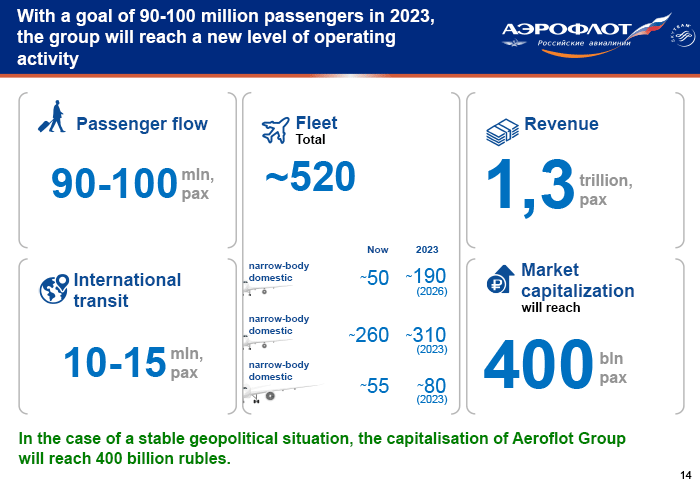
Thus, this is how you will see the Aeroflot Group in 2023. Passenger traffic is 90-100 million passengers per year. International transit - 15 million passengers. The fleet will increase dramatically and will be 520 cars, including 190 domestic (currently we have 50 domestic, 260 single-bodied imported and 55 wide-bodied imported aircraft). We plan this increase by purchasing both domestic and imported equipment. Obviously, without an increase in the fleet of aircraft, we will not be able to transfer so many passengers. Group revenue will be 1.3 trillion. rub. Market capitalisation will reach 400 billion rubles. It is clear that for all this a stable geopolitical situation is needed. Unfortunately, against the background of possible sanctions and general global instability, this can all be corrected. But in the case of comfortable conditions, we believe that those ambitious goals that we set for ourselves will be fulfilled, and for this we will make maximum efforts.
This is what President Vladimir Vladimirovich Putin saw and what you saw. This strategy has been approved by the President, and we hope that it will be approved by you.











